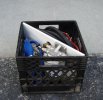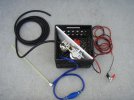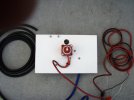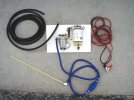My fuel is rather old in my 210cc and I did not want to chance running old fuel through my honda 150.
I decided to drain the fuel from the tank.To empty the tank here is what I tried and what worked and what did not if any of you have to do this in the future.
I'm pretty sure this will work on other boats and motors. I first bought that hand pump thing at Autozone (also sold at lowe's) that is supposed to be a siphon. After buying extra tubes to try to shove it down the fill line the long and short is it would not work. Simply put I could never get even a 1/4" tube to make the bends enough to get down in the fuel tank.
Plan B was to pull the motor cover and disconnect the main fuel line coming from the tank that connects to the filter. I located it and it was 5/16 fuel line. I connected the same siphon pump that I bought and all the extra hoses needed only to find out that it has to be continuously pumped to squirt about an ounce of fuel each pump and would have taken a lifetime to pump out the fuel tank. So this was a failure.
Plan C I then tried to use mouth suction and lower the line below the hull and for some reason this did not work out either as I could not keep flow going.
Plan D which worked like a champ was to purchase 1 electric fuel pump sold at Autozone for about 45.00. You also have to buy and connect and inline 5amp fuse for this pump. You can connect this however you want but I encourage you to buy extra 5/16 fuel line and extra wire to give your self some slack. I connected the suction side of the pump to directly to the main 5/16 hose on the boat that supplies my Honda 150 at the fuel filter. If you want you can use a barb connection and lengthen it depending on your set up. Totally up to you. Just make sure you do not connect it too tight as you will need to unhook it when you are finsihed and will not want to damage your motors fuel line by having to pry the hose off the barb because it was shoved deep on the barb. You then hook another length of 5/16 hose to the output side and place the end in a gas can (I used a 55 gallon drum). I would say use 5 feet on each side as a standard but use more or less depending on what you need. You then connect the positive and negative on the battery of a car or other 12 volt connection. The pump will pump at 4 to 7 psi which is about 25 gallons every hour and a half give or take. Nevertheless you will empty you tank this way without pulling it out. The only mechanical work you will have to do is remove the engine cover and unhook 1 fuel line and connect it back when you are done. I guess the entire set up cost me about 65.00 or so.
I got out about 45 gallons of fuel and the pump started sucking air. I did not manually look at the tanks to see if they were empty but I'm pretty sure it got it all out or if not most of it.
If your fuel lines are 3/8 or another size dont forget to buy barb adapters to adapt the correct size to connect the lines to the pump.
NOTE: Here is a pdf link to instructions for setting up the pump also not you will need teflon tape to seal the screw on filter they provide with the pump.
http://www.mr-gasket.com/pdf/12S_42S.pdf
I decided to drain the fuel from the tank.To empty the tank here is what I tried and what worked and what did not if any of you have to do this in the future.
I'm pretty sure this will work on other boats and motors. I first bought that hand pump thing at Autozone (also sold at lowe's) that is supposed to be a siphon. After buying extra tubes to try to shove it down the fill line the long and short is it would not work. Simply put I could never get even a 1/4" tube to make the bends enough to get down in the fuel tank.
Plan B was to pull the motor cover and disconnect the main fuel line coming from the tank that connects to the filter. I located it and it was 5/16 fuel line. I connected the same siphon pump that I bought and all the extra hoses needed only to find out that it has to be continuously pumped to squirt about an ounce of fuel each pump and would have taken a lifetime to pump out the fuel tank. So this was a failure.
Plan C I then tried to use mouth suction and lower the line below the hull and for some reason this did not work out either as I could not keep flow going.
Plan D which worked like a champ was to purchase 1 electric fuel pump sold at Autozone for about 45.00. You also have to buy and connect and inline 5amp fuse for this pump. You can connect this however you want but I encourage you to buy extra 5/16 fuel line and extra wire to give your self some slack. I connected the suction side of the pump to directly to the main 5/16 hose on the boat that supplies my Honda 150 at the fuel filter. If you want you can use a barb connection and lengthen it depending on your set up. Totally up to you. Just make sure you do not connect it too tight as you will need to unhook it when you are finsihed and will not want to damage your motors fuel line by having to pry the hose off the barb because it was shoved deep on the barb. You then hook another length of 5/16 hose to the output side and place the end in a gas can (I used a 55 gallon drum). I would say use 5 feet on each side as a standard but use more or less depending on what you need. You then connect the positive and negative on the battery of a car or other 12 volt connection. The pump will pump at 4 to 7 psi which is about 25 gallons every hour and a half give or take. Nevertheless you will empty you tank this way without pulling it out. The only mechanical work you will have to do is remove the engine cover and unhook 1 fuel line and connect it back when you are done. I guess the entire set up cost me about 65.00 or so.
I got out about 45 gallons of fuel and the pump started sucking air. I did not manually look at the tanks to see if they were empty but I'm pretty sure it got it all out or if not most of it.
If your fuel lines are 3/8 or another size dont forget to buy barb adapters to adapt the correct size to connect the lines to the pump.
NOTE: Here is a pdf link to instructions for setting up the pump also not you will need teflon tape to seal the screw on filter they provide with the pump.
http://www.mr-gasket.com/pdf/12S_42S.pdf
Last edited:





